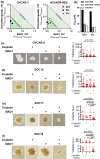Re-engineering Antimicrobial Peptides into Oncolytics Targeting Drug-Resistant Ovarian Cancers
- PMID: 33184577
- PMCID: PMC7596148
- DOI: 10.1007/s12195-020-00626-z
Re-engineering Antimicrobial Peptides into Oncolytics Targeting Drug-Resistant Ovarian Cancers
Abstract
Introduction: Bacteria and cancer cells share a common trait-both possess an electronegative surface that distinguishes them from healthy mammalian counterparts. This opens opportunities to repurpose antimicrobial peptides (AMPs), which are cationic amphiphiles that kill bacteria by disrupting their anionic cell envelope, into anticancer peptides (ACPs). To test this assertion, we investigate the mechanisms by which a pathogen-specific AMP, originally designed to kill bacterial Tuberculosis, potentiates the lytic destruction of drug-resistant cancers and synergistically enhances chemotherapeutic potency.
Materials and methods: De novo peptide design, paired with cellular assays, elucidate structure-activity relationships (SAR) important to ACP potency and specificity. Using the sequence MAD1, microscopy, spectrophotometry and flow cytometry identify the peptide's anticancer mechanisms, while parallel combinatorial screens define chemotherapeutic synergy in drug-resistant cell lines and patient derived ex vivo tumors.
Results: SAR investigations reveal spatial sequestration of amphiphilic regions increases ACP potency, but at the cost of specificity. Selecting MAD1 as a lead sequence, mechanistic studies identify that the peptide forms pore-like supramolecular assemblies within the plasma and nuclear membranes of cancer cells to potentiate death through lytic and apoptotic mechanisms. This diverse activity enables MAD1 to synergize broadly with chemotherapeutics, displaying remarkable combinatorial efficacy against drug-resistant ovarian carcinoma cells and patient-derived tumor spheroids.
Conclusions: We show that cancer-specific ACPs can be rationally engineered using nature's AMP toolbox as templates. Selecting the antimicrobial peptide MAD1, we demonstrate the potential of this strategy to open a wealth of synthetic biotherapies that offer new, combinatorial opportunities against drug resistant tumors.
Keywords: Anticancer peptides; Combinatorial therapy; De novo design; Nanostructures; Supramolecular assembly.
© Biomedical Engineering Society 2020.
Figures






Similar articles
-
Lipopeptisomes: Anticancer peptide-assembled particles for fusolytic oncotherapy.Acta Biomater. 2018 Oct 15;80:269-277. doi: 10.1016/j.actbio.2018.09.025. Epub 2018 Sep 19. Acta Biomater. 2018. PMID: 30240951
-
CancerGram: An Effective Classifier for Differentiating Anticancer from Antimicrobial Peptides.Pharmaceutics. 2020 Oct 31;12(11):1045. doi: 10.3390/pharmaceutics12111045. Pharmaceutics. 2020. PMID: 33142753 Free PMC article.
-
Design of short membrane selective antimicrobial peptides containing tryptophan and arginine residues for improved activity, salt-resistance, and biocompatibility.Biotechnol Bioeng. 2014 Jan;111(1):37-49. doi: 10.1002/bit.25003. Epub 2013 Aug 5. Biotechnol Bioeng. 2014. PMID: 23860860
-
Membrane targeting cationic antimicrobial peptides.J Colloid Interface Sci. 2019 Mar 1;537:163-185. doi: 10.1016/j.jcis.2018.10.103. Epub 2018 Nov 1. J Colloid Interface Sci. 2019. PMID: 30439615 Review.
-
Cationic antimicrobial peptides: potential templates for anticancer agents.Front Med (Lausanne). 2025 Apr 24;12:1548603. doi: 10.3389/fmed.2025.1548603. eCollection 2025. Front Med (Lausanne). 2025. PMID: 40342581 Free PMC article. Review.
Cited by
-
Antimicrobial peptides as drugs with double response against Mycobacterium tuberculosis coinfections in lung cancer.Front Microbiol. 2023 Jun 2;14:1183247. doi: 10.3389/fmicb.2023.1183247. eCollection 2023. Front Microbiol. 2023. PMID: 37342560 Free PMC article. Review.
-
Lung antimicrobial proteins and peptides: from host defense to therapeutic strategies.Physiol Rev. 2024 Oct 1;104(4):1643-1677. doi: 10.1152/physrev.00039.2023. Epub 2024 Jul 25. Physiol Rev. 2024. PMID: 39052018 Review.
-
From oncolytic peptides to oncolytic polymers: A new paradigm for oncotherapy.Bioact Mater. 2023 Aug 14;31:206-230. doi: 10.1016/j.bioactmat.2023.08.007. eCollection 2024 Jan. Bioact Mater. 2023. PMID: 37637082 Free PMC article. Review.
-
Amelioration of Subglottic Stenosis by Antimicrobial Peptide Eluting Endotracheal Tubes.Cell Mol Bioeng. 2023 Jun 29;16(4):369-381. doi: 10.1007/s12195-023-00769-9. eCollection 2023 Aug. Cell Mol Bioeng. 2023. PMID: 37811005 Free PMC article.
-
Proline-rich acidic protein 1 upregulates mitotic arrest deficient 1 to promote cisplatin-resistance of colorectal carcinoma by restraining mitotic checkpoint complex assembly.J Cancer. 2023 May 21;14(9):1515-1530. doi: 10.7150/jca.84048. eCollection 2023. J Cancer. 2023. PMID: 37325046 Free PMC article.
References
-
- Agarwal R, Kaye SB. Ovarian cancer: strategies for overcoming resistance to chemotherapy. Nat. Rev. Cancer. 2003;3:502–516. - PubMed
-
- Aina OH, Liu R, Sutcliffe JL, Marik J, Pan C-X, Lam KS. From combinatorial chemistry to cancer-targeting peptides. Mol. Pharm. 2007;4:631–651. - PubMed
-
- Al-Lazikani B, Banerji U, Workman P. Combinatorial drug therapy for cancer in the post-genomic era. Nat. Biotechnol. 2012;30:679. - PubMed
Grants and funding
LinkOut - more resources
Full Text Sources
Miscellaneous

